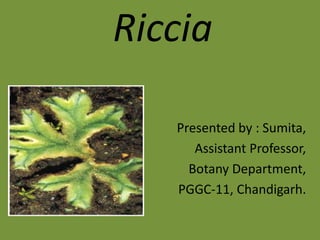
Riccia ppt
- 1. Riccia Presented by : Sumita, Assistant Professor, Botany Department, PGGC-11, Chandigarh.
- 2. Systematic Position Division : Bryophyta Class : Hepaticopsida Order : Marchantiales Family : Ricciaceae Genus : Riccia
- 3. OCCURENCE - The genus was named after an Italian botanist F. F. Ricci - All the species grow as terrestrial plants on damp soils except Riccia fluitans which grows in water - The common Indian species are : R. discolor, R. gangetica, R. frostii, R. melanospora, R. crystallina, R. fluitans
- 5. GAMETOPHYTIC PLANT BODY • thalloid body • small, flat, dorsiventral • dichotomously branched • dorsal surface shows prominent midrib • growing point is situated in the apical notch • ventral surface shows the presence of a large number of rhizoids and scales
- 6. Scales and Rhizoids Two types of rhizoids: • Smooth walled : smooth inner walls, living cells, main function is absorption • Tuberculate : peg like projections in inner wall, devoid of protoplasm, main function is mechanical support Scales: • present on the ventral surface of thallus • simple and ligulate type • help to protect the growing point • each scale is simple, multicellular and one cell in thickness
- 7. INTERNAL STRUCTURE Photosynthetic Zone : 1) consists of compactly arranged vertical rows of chlorenchymatous cells (assimilatory filaments) separated by narrow vertical air chambers. 2) cells possess chloroplasts and perform photosynthesis. Storage zone : 1) consists of compact, colourless parenchymatous tissue without intercellular spaces. 2) cells contain abundant starch grains. 3) few cells of lower epidermis elongate to produce rhizoids.
- 8. REPRODUCTION • Vegetative Reproduction : 1) Fragmentation 2) Formation of adventitious branches 3) Persistent growing apices 4) Formation of tubers • Sexual Reproduction : - oogamous - male sex organs are antheridia (borne in antheridial chambers)and female sex organs are archegonia (borne in antheridial chambers) - some of the species are monoecious and some are dioecious - sex organs arise singly in acropetal succession (youngest at the apex and oldest at the base)
- 9. STRUCTURE OF ANTHERIDIUM • differentiated into two parts : stalk and body of antheridium • body of antheridium consists of single layered jacket enclosing a mass of androcytes • each androcyte differentiates to produce single biflagellated antherozoid
- 11. DEHISCENCE OF ANTHERIDIUM • At maturity, the pore of antheridial chamber becomes wide open • antherozoids float in a viscous fluid formed by dissolution of cell walls of androcytes • sterile jacket of antheridium imbibes water, become softned and disorganises • antherozoids ooze out in mass through an opening • antherozoids escape and come to dorsal surface of thallus • where they swim in the film of water present on the dorsal surface of thallus due to rain or dew • the presence of water is essential for the liberation of antherozoids
- 12. STRUCTURE OF ARCHEGONIUM It is a flask shaped structure differentiated into three parts : 1) Stalk. 2) Swollen Venter : Consists of single layered wall. It encloses a venter canal cell and a large naked egg. 3) Long neck : consists of 6 - 9 tiers of cells arranged in six vertical rows, surrounding a narrow neck canal.
- 13. FERTILIZATION - occurs in the presence of water provided by rain or dew. - water is needed for dehiscence of antheridia, liberation of antherozoids, opening of archegonial neck, movement of antherozoids to archegonia. - at maturity, the neck canal cells and venter canal cell disintegrates and become mucilaginous. - the mucilaginous substance, when hydrated, exerts a pressure so that the cover cells spread apart. - a passage is created at the opening of archegonial neck through which some of the mucilaginous substance oozes out. - antherozoids are attracted chemotactically towards some chemical substances present in mucilage. - some of them enter into the neck canal. - a single antherozoid which reaches first, fuses with the egg. - fusion results in the formation of diploid zygote. - the gametophytic phase of the life cycle ends with the formation of zygote.
- 15. ZYGOTE • First cell of sporophytic generation • It is diploid • The zygote is retained inside the venter and starts germinating • It produces diploid sporophytic plant body (i.e. the sporogonium) which is dependent on gametophytic plant body
- 16. STRUCTURE OF MATURE SPOROGONIUM • embedded centrally in the tissue of gametophyte plant body • represented only by the capsule (spore sac), foot and seta are absent • consists of mass of spores enclosed within the outer layer of calyptra • the spores are generally attached in tetrads • spores are haploid and are the first cells of sporophytic generation • the calyptra layer is a part of gametophyte • spores are enclosed within the gametophytic thalli untill the thallus dies and decays • after that spores are set free in the soil and dispersed by the wind or rain
- 17. SPORE - first cell of gametophytic generation - it consists of a mass of cytoplasm with a small haploid nucleus - spore wall differentiated into outer exine and inner intine - exine is hard, thick and intine is thin, translucent
- 18. GERMINATION OF SPORES - There is no resting period - the germination requires presence of light, low temperature and sufficient moisture - The spores absorb moisture and swell - a germ tube emerges out through a germ pore - the dense protoplasm flows through the germ tube to its distal end which cuts a large terminal cell - first rhizoid is formed near the base of tube - the terminal cell divides resulting in the formation of two tiers of four cells each - further growth results in the formation of a young flat thallus
- 19. LIFE CYCLE SHOWING ALTERNATION OF GENERATIONS • Life cycle is diplohaplontic. • Alternation of generations is heteromorphic type since the plant bodies of two generations are morphologically dissimilar.
- 20. THANKS